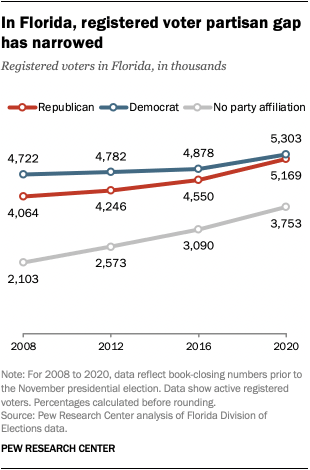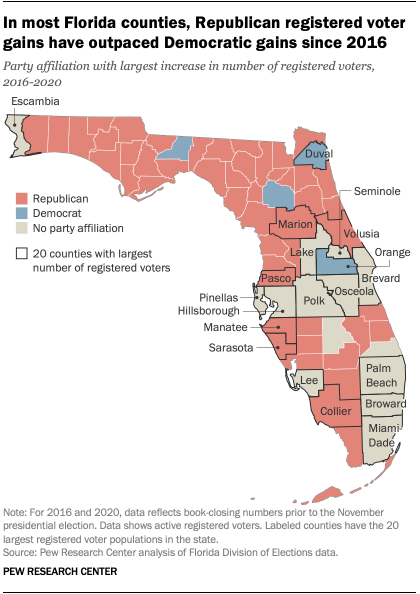More Floridians have registered to vote as Republicans than Democrats since the 2016 presidential elections, continuing a trend seen in previous presidential cycles and sharply narrowing the Democratic Party’s advantage, according to a Pew Research Center analysis of Florida state government data.
There currently are 5.30 million registered Democrats and 5.17 million registered Republicans in the state – an edge of about 134,000 voters in favor of the Democrats. But the size of that margin has fallen from 327,000 in 2016 and 658,000 in 2008.
Democrats and Republicans now make up similar shares of Florida’s registered voters (37% and 36%, respectively), compared with 26% who have no party affiliation. In 2008, the Democratic share of voters was 6 percentage points higher than that of Republicans (42% vs. 36%).
For this report, we analyzed the number of people registered to vote in Florida, including their distribution by party affiliation and county of residence, based on data from the Florida Division of Elections.
There has been greater growth in the number of Floridians registered to vote as Republicans than as Democrats since 2016. The number of Republican voters has risen by about 619,000, compared with an increase of 426,000 voters among Democrats. However, the biggest increase during this period has been among those who are registered with no party (+663,000).
While the unaffiliated make up 26% of Florida’s registered voters in 2020, relatively few voters cast a ballot for third-party presidential candidates in the state’s elections. In 2016, Donald Trump narrowly beat Hillary Clinton in Florida, 49% vs. 48%, with third-party candidates winning 3% of the vote.
A perennial battleground state in presidential elections, Florida has added 1.6 million registered voters since the 2016 election, which is substantially more than the two previous presidential election cycles (929,000 between 2012 and 2016; 687,000 between 2008 and 2012). These figures are as of Florida’s “book closing” date on Oct. 6 and represent final voter registration figures for the Nov. 3 general election.
When it comes to those eligible to register as voters in Florida, demographics have shifted in recent decades as the number of Hispanic eligible voters has grown faster than other groups. In addition, the state has one of the largest immigrant eligible voter populations in the nation. (Eligible voters are not the same as registered voters. Eligible voters are adult U.S. citizens, but not all eligible voters have registered to vote.)
In 49 of the state’s 67 counties, the increase in Republican registered voters since 2016 exceeded that of Democratic and unaffiliated registered voters.
However, in a majority of counties with large registered voter populations (i.e., counties with the 20 largest registered voter populations), the biggest increase has been among those who are registered with no party affiliation. For example, in Miami-Dade, Broward, Palm Beach and Hillsborough – counties with the four largest registered voter populations, accounting for 33% of the state’s registered voters – more people have registered with no party affiliation than as Republicans or Democrats since 2016.


